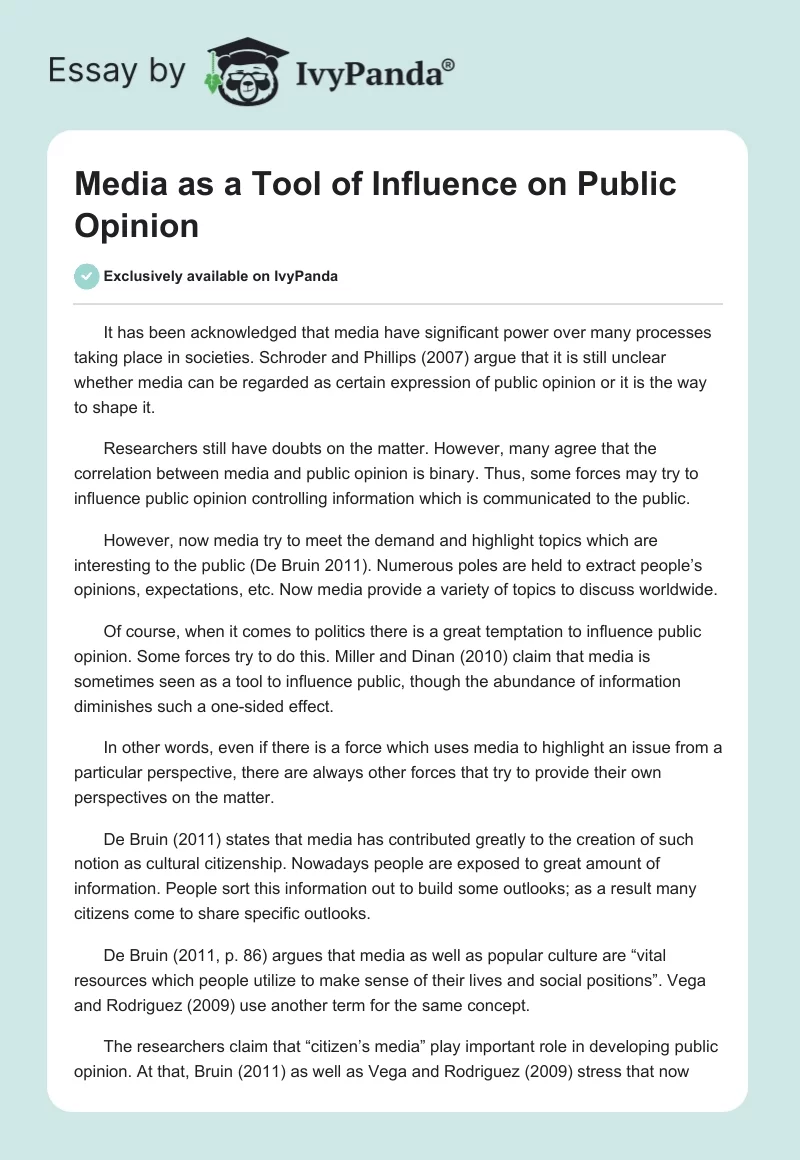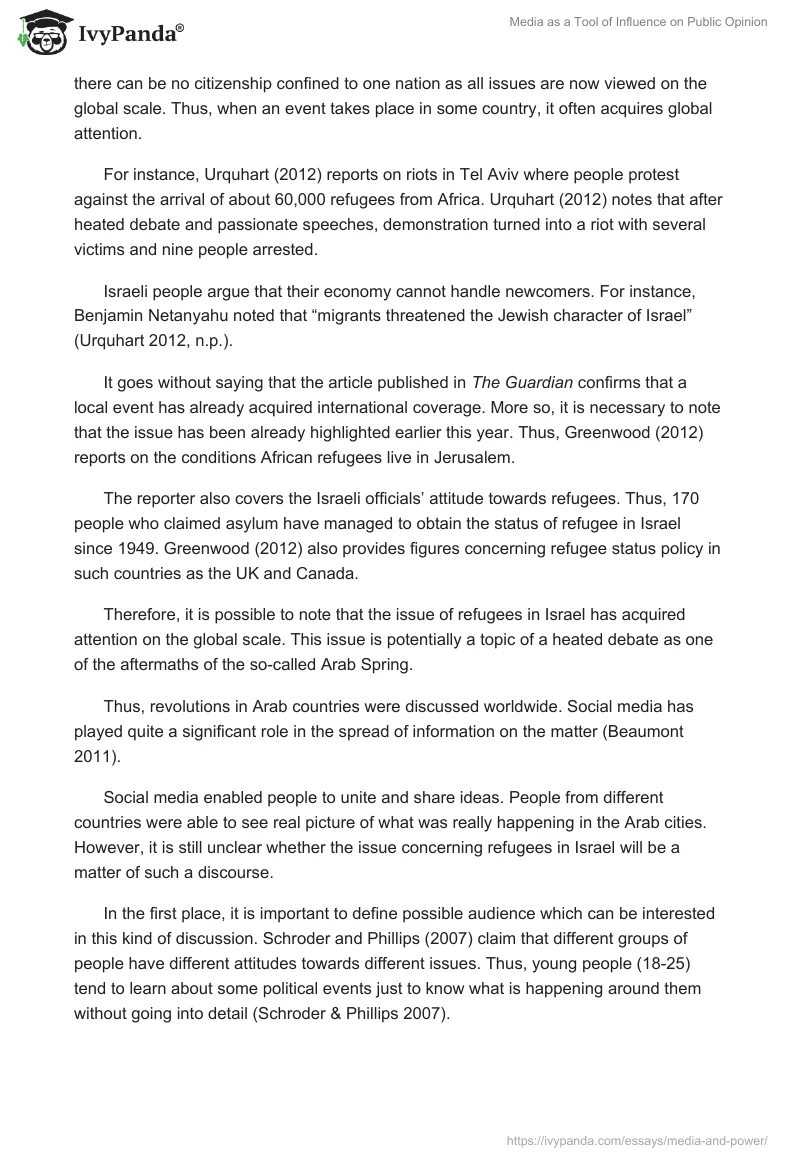It has been acknowledged that media have significant power over many processes taking place in societies. Schroder and Phillips (2007) argue that it is still unclear whether media can be regarded as certain expression of public opinion or it is the way to shape it.
Researchers still have doubts on the matter. However, many agree that the correlation between media and public opinion is binary. Thus, some forces may try to influence public opinion controlling information which is communicated to the public.
However, now media try to meet the demand and highlight topics which are interesting to the public (De Bruin 2011). Numerous poles are held to extract people’s opinions, expectations, etc. Now media provide a variety of topics to discuss worldwide.
Of course, when it comes to politics there is a great temptation to influence public opinion. Some forces try to do this. Miller and Dinan (2010) claim that media is sometimes seen as a tool to influence public, though the abundance of information diminishes such a one-sided effect.
In other words, even if there is a force which uses media to highlight an issue from a particular perspective, there are always other forces that try to provide their own perspectives on the matter.
De Bruin (2011) states that media has contributed greatly to the creation of such notion as cultural citizenship. Nowadays people are exposed to great amount of information. People sort this information out to build some outlooks; as a result many citizens come to share specific outlooks.
De Bruin (2011, p. 86) argues that media as well as popular culture are “vital resources which people utilize to make sense of their lives and social positions”. Vega and Rodriguez (2009) use another term for the same concept.
The researchers claim that “citizen’s media” play important role in developing public opinion. At that, Bruin (2011) as well as Vega and Rodriguez (2009) stress that now there can be no citizenship confined to one nation as all issues are now viewed on the global scale. Thus, when an event takes place in some country, it often acquires global attention.
For instance, Urquhart (2012) reports on riots in Tel Aviv where people protest against the arrival of about 60,000 refugees from Africa. Urquhart (2012) notes that after heated debate and passionate speeches, demonstration turned into a riot with several victims and nine people arrested.
Israeli people argue that their economy cannot handle newcomers. For instance, Benjamin Netanyahu noted that “migrants threatened the Jewish character of Israel” (Urquhart 2012, n.p.).
It goes without saying that the article published in The Guardian confirms that a local event has already acquired international coverage. More so, it is necessary to note that the issue has been already highlighted earlier this year. Thus, Greenwood (2012) reports on the conditions African refugees live in Jerusalem.
The reporter also covers the Israeli officials’ attitude towards refugees. Thus, 170 people who claimed asylum have managed to obtain the status of refugee in Israel since 1949. Greenwood (2012) also provides figures concerning refugee status policy in such countries as the UK and Canada.
Therefore, it is possible to note that the issue of refugees in Israel has acquired attention on the global scale. This issue is potentially a topic of a heated debate as one of the aftermaths of the so-called Arab Spring.
Thus, revolutions in Arab countries were discussed worldwide. Social media has played quite a significant role in the spread of information on the matter (Beaumont 2011).
Social media enabled people to unite and share ideas. People from different countries were able to see real picture of what was really happening in the Arab cities. However, it is still unclear whether the issue concerning refugees in Israel will be a matter of such a discourse.
In the first place, it is important to define possible audience which can be interested in this kind of discussion. Schroder and Phillips (2007) claim that different groups of people have different attitudes towards different issues. Thus, young people (18-25) tend to learn about some political events just to know what is happening around them without going into detail (Schroder & Phillips 2007).
Such superficial knowledge can be enough to understand what topics are being discussed. Schroder and Phillips (2007, p. 896) note that young people exclude newspapers “from their news menu with the legitimation of lack of time”. The Internet is one of the primary sources of information for young people who claim they simply do not have time to go into detail.
On the contrary, older people (35-50) tend to learn all meaningful details and analyze them (Schroder & Phillips 2007). These people see themselves as “socially engaged citizens to whom it matters to be well-informed” (Schroder & Phillips 2007, p. 897).
These people tend to analyze backgrounds of the events and think of possible outcomes. These people have a significant knowledge on the matter, which is crucial for the deep analysis of the problem.
As far as the issue of African refugees in Israel is concerned, it is quite difficult to define the audience. On the one hand, older people are likely to participate in a debate on the matter. This debate will include all possible pros and cons. “Socially engaged citizens” are likely to come up with ideas to solve the problem.
Some of them are likely to take the side of the refugees while others are likely to support the other party. At any rate, these citizens will be really precise while expressing their opinions.
Seemingly, young people will not be in interested in entering the discourse. As has been mentioned above young people simply want to understand what events do take place worldwide. Nonetheless, it is highly likely that these young citizens will be the force that will make a difference in this particular case.
Thus, Beaumont (2011) argues that some think the power of social media or even media on the whole was overestimated when evaluating its role during the Arab Spring. The researcher claims that quite limited amount of information appeared online. Nonetheless, the author adds that even this amount was enough to raise awareness about the issue and help people form the necessary media citizenship.
At that, it is mentioned that predominantly young people used social media as older people still do not excessively use the Internet. When it comes to some autocratic countries, social media can be the only source of information as other sources of information can be quite easily controlled by autocratic governments.
Obviously, young people are likely to raise awareness about some issues which take place in this or that situation. Young people are likely to share information via numerous social media. There are many examples illustrating young people’s activism.
Dehghan (2012) reports on the message created by Israeli people who propagate peace among the people of Israel and Iran. Interestingly, the vast majority of people featured in the message are young people. Therefore, despite superficial knowledge on different matters young people tend to take active part in various processes. Hence, it is possible to note that the issue potentially has a really wide audience.
However, it is important to note that this attention can remain rather restricted. Meraz (2009) claims that not all issues obtain global media coverage. First, even within the domain of social media there is some sort of disparity. The disparity can be easily explained.
There are groups of people who do not have access to media. As has been mentioned above, in Arab countries (during the Arab Spring) quite a restricted number of users in Arab countries could share information. Therefore, many people were deprived of possibility to tell their stories. Nonetheless, the stories told made people develop media citizenship.
In the case with African refugees, it is possible to assume that these people can count on support of media rather than on the support of social media. Many of these people simply do not have access to social media which could fuel the global discussion of the issue. Admittedly, refugees flee their countries leaving everything behind. There is no time to think of going online to tell the story when villages are being burnt down.
For instance, Greenwood (2012) tells a story of Mubarak, 18, who fled his homeland when his village was destroyed. The young man tells about his life in a detention camp. Obviously, the conditions people find themselves in these camps are really harsh.
Admittedly, if hundreds of people could tell their stories, there would be more attention to the problem. A couple of newspaper articles are proved to be insufficient to form media citizenship in this particular domain. African refugees need assistance which they can have if they address global citizens’ media.
Clearly, some more time is necessary to see whether African refugees will manage to draw attention to their conditions. So far people have not formed any significant media citizenship in this very domain. However, there are chances that this issue will acquire global attention.
Only several more stories are to be told to raise awareness among people. Social media can play crucial role in this process. As has been mentioned above, the issue has a really wide audience. At that, young people are likely to play a role of initiators of the debate, again.
The potential scenario for the development of the situation is as follows. Many more messages will appear in social media. People will be able to share their stories. Numerous pictures featuring refugees’ life can appear online. These messages will fuel the debate which will eventually lead to creation of media citizenship in this particular domain.
The issue will be discussed globally, which in its turn can lead to specific solutions. Of course, there are still chances that the issue concerning African refugees will not acquire global attention. However, the case of the revolutions in Arab countries suggests that social media will also play an important role in addressing aftermaths of the revolutions in the region.
Reference List
Beaumont, P., 2011. ‘The truth about Twitter, Facebook and the uprisings in the Arab world‘. Web.
De Bruin, J., 2011. ‘Shortland Street audiences and cultural citizenship’, Continuum 25.1, pp. 85-97.
Dehghan, S. K., 2012. ‘A message to Iran from Israel: I love you‘, The Guardian. Web.
Greenwood, P., 2012. ‘Huge detention centre to be Israel’s latest weapon in migration battle‘. Web.
Meraz, S., 2009. ‘ The many faced “you” of social media’, in Z Papacharissi (ed.), Journalism and citizenship: new agendas in communication, Taylor & Francis, New York.
Miller, D. & Dinan, W., 2010. ‘Introduction’, in J Klaehn (ed.), The political economy of media and power, Peter Lang, New York.
Schroder, K. & Philips, L., 2007. ‘Complexifying media power: a study of the interplay between media and audience discourses on politics ‘, Media, Culture & Society 29.6, pp. 890-915.
Urquhart, C., 2012. ‘African asylum seekers injured in Tel Aviv race riots‘, The Guardian. Web.
Vega, J. & Rodriguez, C., 2009. ‘Citizen’s media as political subjects: the case of community radio in Colombia’, in DK Thussu (ed.), Internationalizing media studies, Taylor & Francis, New York.


